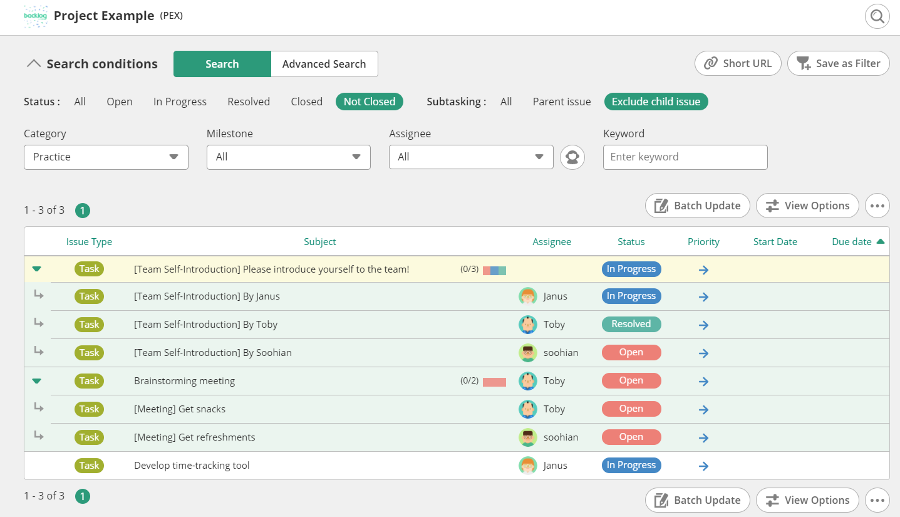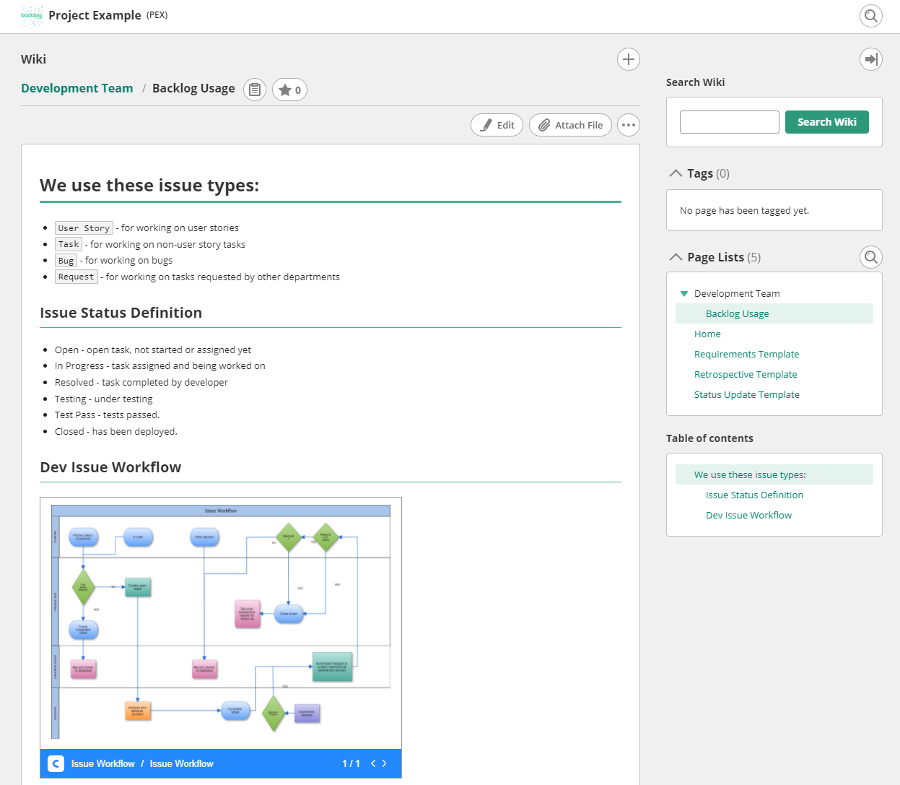Three steps to introduce Backlog successfully
Backlog Staff
September 20, 2020
We know Backlog is a tool for positive change and optimization in the workplace. The many teams that are using Backlog sought us out to improve their collaboration and become a more efficient team or organization.
At the same time, we recognize that implementing and managing change is challenging. Introducing a new tool like Backlog to your team or organization can lead to big changes in workflow, and the process requires some finesse to ensure everyone can get onboarded successfully.
In this article, we’ll share some ideas on how to introduce Backlog to your team and maintain enthusiasm for change in your organization so that, together, you have a strong foundation for effectively using Backlog and increasing your productivity!
Step 1: Start small with your team
Start by assigning small tasks to a few of your team members to practice task management. A small task is easy to do and can be completed within a short period of time.
For example:
- Perform simple tasks such as introducing yourself or updating your profile settings in a practice project.
- Manage small tasks such as office or team chores.
- Manage event tasks such as an internal meeting or discussion.
- Developers can try doing technical research tasks, or develop a small in-house program.
The main reason for starting small is to find out if the people around you like using Backlog. If they feel good about it, they are more likely to continue using the tool and will use it for other tasks.
When a new tool or way of working is introduced, everyone will feel a certain resistance to it. One trick to lower psychological resistance is to complete simple tasks and achieve early success with the tool. Logically, taking on small tasks is a great first step, and team members can also build up their confidence in using Backlog.
Step 2: Use Backlog deliberately for your team’s work
After completing small tasks on Backlog, if enough team members like Backlog and feel that it will help improve the work process, the time is ripe to introduce Backlog into your team’s work. Rather than letting Backlog naturally spread to other members, we find that a deliberate and planned process will help the team avoid confusion.
Design the team’s usage of Backlog
- Organize Backlog issues by setting the issue types, categories, and milestones for the project.
- Determine rules such as issue management flow and status definition.
Issue management flow refers to the team’s workflow, their process of working on a task/issue from start to finish, and the respective members involved.
Status definition refers to how the team defines the status of the issue or task. Do you consider “Resolved” as “Closed”? Besides the preset statuses available in Backlog, consider if you wish to use custom statuses to better define the workflow. E.g. custom statuses like In Review, Pending QC, etc.
Since Backlog is used for task management and collaboration between members, it’s important to organize how the team will use Backlog for work and establish a common definition of task statuses at the beginning.
Start by designing or documenting the operation/usage rules to be used by team members. You don’t need long or overly detailed rules. Even summarizing the above points into minimum bullet points will greatly improve the organization of your Backlog usage.
Backlog usage rules can be placed on the project Wiki page, together with embedded Cacoo diagrams, so that members can easily access the information and continue to update it in the future.
Measure work performance and make improvements
- Quantitative: Is the work time spent on tasks/collaboration streamlined? Did you improve your KPI/OKR performance?
- Qualitative: Is the work process or communication smoother and easier? Where are the trouble spots or bottlenecks while using Backlog?
Measure your team’s performance and consider what is effective and what needs to be corrected at regular intervals. If you’re not getting the desired results, you can figure out where the problem lies.
Then, make adjustments and revise your usage/operation of Backlog accordingly. By doing so, your team can optimize work processes and become more productive.
However, there are two points to note:
First of all, avoid sudden and drastic changes, like replacing your entire work process in Backlog or changing everything you’ve done so far. As with step 1, taking small steps is the rule. It’s important to learn through small mistakes, accumulate and build upon small successes, and gradually acquire confidence and mastery along the way.
Secondly, there are always teething problems when using a new tool and people are forced to change their accustomed work habits. So, performance is bound to take a hit in the early stages. It’s important to bear this in mind as you or your team members may unexpectedly feel frustrated or disappointed at not achieving the desired results yet.
Step 3: Spread Backlog to other teams
When your team is settled in on Backlog and has optimized their work, other teams or departments in your organization may be interested in your results. This is your opportunity to share about Backlog with them, thus sparking a productive transformation within your organization.
Share your Backlog experience:
- Share about your team’s experience, including the good and bad.
- Summarize how your team used Backlog, operation rules, and workflow.
These resources will encourage other teams and departments to consider how they can increase efficiency at work using Backlog, and for a team facing the same challenges, learning about your team’s accomplishments can be a big help. Documenting these will also allow you to quickly share your team’s experiences when you’re asked to report on or justify the use of Backlog to other managers.
What you should not do
Finally, here’s what you should not do when you are introducing Backlog use:
- Try to change everything immediately
- Expect dramatic results from the very beginning
- Give up on change
In striving to improve, we tend to be ambitious and have far-reaching visions, but the reality is often different from our aspirations. Organizational change usually involves more effort and resistance than we might imagine.
Plus, the larger the change, the greater the risk and costs of making those changes. Furthermore, we may not be able to maintain our momentum or achieve the spectacular results we envisioned instantly, and so, return with disappointment.
The trick to making a change is to start small, fail small, and build small successes. There is no magic spell that can produce change overnight, so we have to proceed with small and steady steps.
Succeeding with Backlog
Not only for Backlog but for any new initiative to take root in an organization, we need to use a step-by-step approach rather than taking huge leaps and expecting dramatic breakthroughs.
We recommend the methods we’ve already detailed, but in practice, each team or organization will need to act based on its unique situation. The main idea is to “fail small, succeed small.”
References:
This post was adapted from our Backlog Japanese blog, Three Steps to Establish Backlog in Your Organization — Not a one-day change, written by Nulab staff Rito Nabeshima.
The original article was also inspired by ideas on organizational change from the book Fearless Change by Mary Lynn Manns, Ph.D. and Linda Rising, Ph.D.




